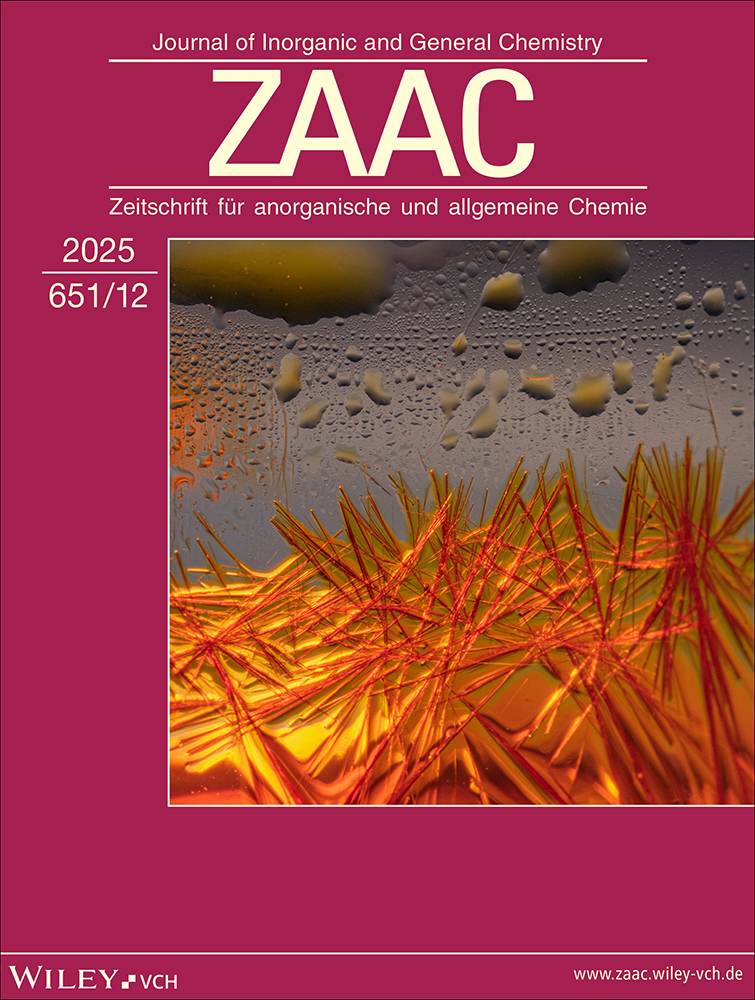Synthese von substituierten Calcium-bis(disilylamiden) mittels der Transmetallierung von Zinn(II)- und Zinn(IV)-amiden†
Professor Max Herberhold zum 60. Geburtstag gewidmet
Abstract
deStannylene und Stannane mit substituierten Disilylamino-Substituenten eignen sich als Edukte für die Transmetallierungsreaktion zur Synthese von Calcium-bis(disilylamiden). Anwendung fanden Bis[2,2,5,5-tetramethyl-2,5-disilaaza-cyclo-pentyl]stannylen 1 und Bis[trimethylsilyl-tris(trimethylsilyl)silylamino]stannylen 2 (monoklin, P21/c, a = 1492,6(2), b = 1705,2(2), c = 1865,3(3) pm, β = 109,03(2)º, Z = 4). Bei der Verwendung von 2 greift das destillierte Calcium allerdings nicht nur die Sn—N-, sondern auch die NSi-Bindung an. Ähnlich wie bei dem Quecksilber-bis[trimethylsilyl-tris(trimethylsilyl)silylamid] 3 beobachtet man bereits bei Tageslicht die homolytische Spaltung der SnN- bzw. HgN-Bindung und die Bildung des Trimethylsilyl-tris(trimethylsilyl)silylamino-Radikals 5 (g = 2,00485; a(N) = 16,2G). Der heterogen geführte Zinn-Calcium-Austausch bei Verbindung 1 in THF führt in guten Ausbeuten zum Tris(tetrahydrofuran-O)calcium-bis[2,2,5,5-tetramethyl-2,5-disilaaza-cyclo-pentanid] 4 (monoklin, P21/n, a = 1060,9(2), b = 1919,3(5), c = 1686,0(3) pm, β = 90,30(2)º, Z = 4). Auch die Stannane Men–4Sn[N(SiMe3)2]n mit n = 1 oder 2 eignen sich als Synthone zur Synthese von Bis(tetrahydrofuran-O)calcium-bis[bis(trimethylsilyl)amid].
Abstract
enSynthesis of Substituted Calcium-bis(disilylamides) by Transmetalation of Tin(II) and Tin(IV) Amides
Stannylenes as well as stannanes with substituted disilylamino groups are valuable synthons for the synthesis of alkaline earth metal bis(disilylamides) via the transmetallation reaction. Whereas bis[2,2,5,5-tetramethyl-2,5-disilaaza-cyclo-pentyl]stannylene 1 is a suitable reagent for this type of reaction, bis[trimethylsilyl-tris(trimethylsilyl)silylamino]stannylene 2 (monoclinic, P21/c, a = 1492.6(2), b = 1705.2(2), c = 1865.3(3) pm, β = 109.03(2)º, Z = 4) is not only attacked at the SnN-bond but also the NSi-bond is cleaved by calcium metal. Similar light sensitivity as for 2 is observed for the mercury bis[trimethylsilyl-tris(trimethylsilyl)silylamide] 3, the homolytic MN-bond cleavage leads to the formation of the trimethylsilyl-tris(trimethylsilyl)silylamino radical (g = 2.00485; a(N) = 16.2 G). The calcium tin exchange reaction of 1 in THF yields tris(tetrahydrofuran-O)calcium-bis[2,2,5,5-tetramethyl-2,5-disilaaza-cyclo-pentanide] 4 (monoclinic, P21/n, a = 1060.9(2), b = 1919.3(5), c = 1686.0(3) pm, β = 90.30(2)º, Z = 4). The stannanes Men-4Sn[N(SiMe3)2]n with n = 1 or 2 are also valuable materials for the synthesis of bis(tetrahydrofuran-O)calcium-bis[bis(trimethylsilyl)amide].




